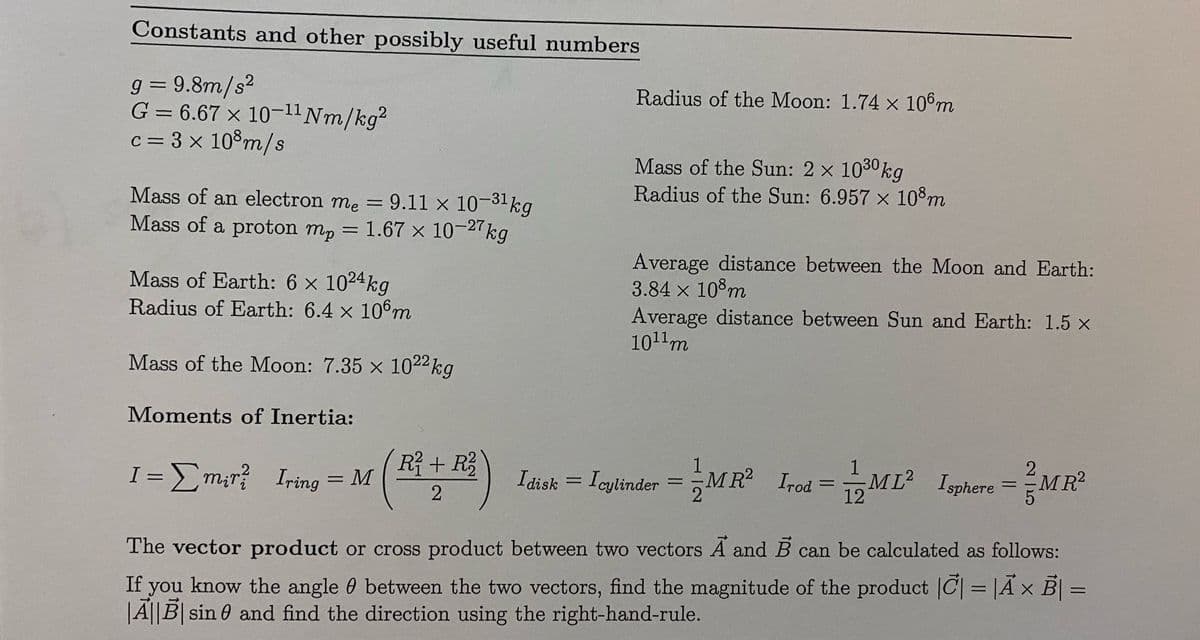Extra: A very rare but occasionally observed decay of a muon u (rest energy = 106 MeV) is nto an electron e (rest energy 0.511 MeV) and a photon y (rest energy decays at rest by this mode, what is the kinetic energy of the electron and photon combined after the decay? (1MEV = 10°eV = 1.6 x 10-13 J) zero). If a muon
Extra: A very rare but occasionally observed decay of a muon u (rest energy = 106 MeV) is nto an electron e (rest energy 0.511 MeV) and a photon y (rest energy decays at rest by this mode, what is the kinetic energy of the electron and photon combined after the decay? (1MEV = 10°eV = 1.6 x 10-13 J) zero). If a muon
University Physics Volume 3
17th Edition
ISBN:9781938168185
Author:William Moebs, Jeff Sanny
Publisher:William Moebs, Jeff Sanny
Chapter5: Relativity
Section: Chapter Questions
Problem 71P: (a) Beta decay is nuclear decay in which an electron is emitted. If the electron is given 0.750 MeV...
Related questions
Question

Transcribed Image Text:106 MeV) is
Extra: A very rare but occasionally observed decay of a muon µ (rest energy =
into an electron e (rest energy 0.511 MeV) and a photon y (rest energy
decays at rest by this mode, what is the kinetic energy of the electron and photon combined
after the decay? (1M V = 10°eV = 1.6 x 10-13 J)
zero). If a muon

Transcribed Image Text:Constants and other possibly useful numbers
g = 9.8m/s?
G = 6.67 × 10-11 Nm/kg?
c= 3 x 10°m/s
Radius of the Moon: 1.74 x 106m
Mass of the Sun: 2 x 1030kg
Radius of the Sun: 6.957 x 10°m
Mass of an electron me =9.11 x 10-31kg
Mass of a proton mp
1.67 x 10-27kg
%3D
Average distance between the Moon and Earth:
3.84 x 10 m
Average distance between Sun and Earth: 1.5 x
1011m
Mass of Earth: 6 x 1024kg
Radius of Earth: 6.4 x 106m
Mass of the Moon: 7.35 x 1022kg
Moments of Inertia:
R+ R
2.
MR²
1
2
I =Em;r? Iring = M
Idisk =ML Igphere =M R
= Icylinder =MR Irod
I disk
%3D
%D
%3D
12
The vector product or cross product between two vectors A and B can be calculated as follows:
If you know the angle 0 between the two vectors, find the magnitude of the product |C| = |Ã × B| =
|A||B| sin 0 and find the direction using the right-hand-rule.
%3D
Expert Solution
This question has been solved!
Explore an expertly crafted, step-by-step solution for a thorough understanding of key concepts.
This is a popular solution!
Trending now
This is a popular solution!
Step by step
Solved in 2 steps with 2 images

Recommended textbooks for you

University Physics Volume 3
Physics
ISBN:
9781938168185
Author:
William Moebs, Jeff Sanny
Publisher:
OpenStax

College Physics
Physics
ISBN:
9781938168000
Author:
Paul Peter Urone, Roger Hinrichs
Publisher:
OpenStax College

Principles of Physics: A Calculus-Based Text
Physics
ISBN:
9781133104261
Author:
Raymond A. Serway, John W. Jewett
Publisher:
Cengage Learning

University Physics Volume 3
Physics
ISBN:
9781938168185
Author:
William Moebs, Jeff Sanny
Publisher:
OpenStax

College Physics
Physics
ISBN:
9781938168000
Author:
Paul Peter Urone, Roger Hinrichs
Publisher:
OpenStax College

Principles of Physics: A Calculus-Based Text
Physics
ISBN:
9781133104261
Author:
Raymond A. Serway, John W. Jewett
Publisher:
Cengage Learning

Classical Dynamics of Particles and Systems
Physics
ISBN:
9780534408961
Author:
Stephen T. Thornton, Jerry B. Marion
Publisher:
Cengage Learning

Modern Physics
Physics
ISBN:
9781111794378
Author:
Raymond A. Serway, Clement J. Moses, Curt A. Moyer
Publisher:
Cengage Learning